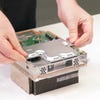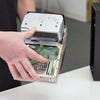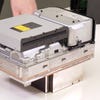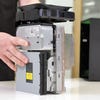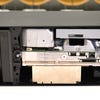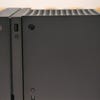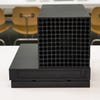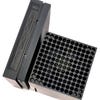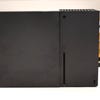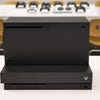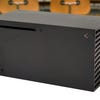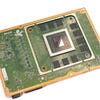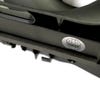Building Xbox Series X: why Microsoft redefined the console form factor
The story behind the box.
Undoubtedly the biggest surprise of The Game Awards back in December 2019 was Microsoft's decision to reveal Xbox Series X: the name, the branding - and most crucially, the form factor. It was a console quite unlike anything we'd seen before, possibly the most original home console design since Nintendo's GameCube way back in 2001. During our recent visit to the Microsoft campus in Redmond WA, we had a chance to meet key members of the hardware team that created this remarkable-looking device - and in the process, we gained a much better understanding of why Xbox Series X required a top to bottom revamp of the traditional console form factor.
"When we started thinking about how we would design this, everything was theoretical," says Chris Kujawski, principal designer at Microsoft. "We didn't have stuff we could test, we didn't have measurements we could take, we knew it was going to be powerful and we knew it was going to require a totally different way of thinking about how to design a console."
The key issue facing the designers came down to power and target performance. The Xbox system architects decided from the get-go that the next generation console had to deliver an absolute minimum of twice the overall graphics performance of the Xbox One X, meaning 12 teraflops of GPU compute, sitting alongside the Zen 2 cores that would deliver a 4x improvement in CPU power. At the same time, the mandate was set that the machine also had to equal the acoustic performance of the Xbox One X - a tall order when system power would be increasing significantly.
The challenge came into focus once the outsize power requirements of the new hardware came into focus. Based on the prototype hardware we saw, Xbox Series X ships with a 315W power supply and in keeping with all of Microsoft's console designs since Xbox Series S, this would be delivered internally. With the sheer amount of electrical power pumping through the processor, the regulators pump up to 100W per square inch, delivering up to 190A. What made this all coalesce into the form factor we have today is the key decision to move to a split motherboard design: one board houses the high-power components like the Series X processor, the GDDR6 and the power regulators. The other is the Southbridge board, principally handling I/O. The boards sit on either side of a substantial chassis block - a sheer aluminium casting.
"I like to think about our past generations as having a bit of an exoskeleton, so you have a mechanical structure with electrical shielding all on the outside then you have all the guts in the inside," explains Jim Wahl, director of mechanical engineering for Xbox hardware. "And so what we did in this generation is that we turned that completely inside out... and so this centre chassis essentially forms the spine, the foundation of this system and then we build things out from there."
"This is actually my favorite part of the console on the inside," adds Chris Kujawski. "It's like it's the coolest part that anybody who actually buys the console will never actually see." It's also essential in keeping the thermal demands of the hottest components in check. "It creates what we call a parallel cooling architecture, so you get cool air in - and cool air streams through separate zones of the console," adds Wahl. "The second thing it does is that it actually distributes the heat sources a bit differently in the console - so those two things together are really effective at cooling a console. And then the third thing it does is... we play this sort of 3D Tetris game, where you're trying to figure out where the components should go and what's the best arrangement - and then that starts to establish some of the dimensional aspects."
While all of this is happening, Chris Kujawski is literally building an Xbox Series X right in front of us using all of these component parts - an exercise we would be carrying out ourselves the following day when it came to producing the video content at the top of this page. The two main boards are of broadly equivalent size, slotting into place on either side of the chassis. I'm reminded more of the old Apple Mac Pro design rather than any kind of console I'd seen before. "So already you can see how these larger components are being Tetrissed together," says Kujawski. "Already you can tell it's going to be a very different kind of shaped product than we've ever done before."
Along with the 4K UHD Blu-ray optical drive and the 315W power supply, electrical shielding is added to the construction. There's a real balancing act to this. Essentially, electromagnetic radiation has to be contained within the machine, but at the same time, Xbox Series X has to dissipate a lot of heat. "What's interesting is that if you look up previous generations, we always had a very nice piece of metal around [the internals] like a Faraday cage," says Andres Hernandez, director of electrical engineering for Xbox. "This time, we had to think a little outside the box. We have board-level shields. We have localised shielding, instead of having that huge piece of metal shielding."
| Xbox Series X | Xbox One X | Xbox One S | |
|---|---|---|---|
| Dimensions | 15.1cm x 15.1cm x 30.1cm | 30cm x 24cm x 6cm | 29.5cm x 23cm x 6.5cm |
| Total Volume | 6.86 litres | 4.32 litres | 4.41 litres |
| Weight | 4.45kg/9.8lbs | 3.69kg/8.14kg | 2.90kg/6.4lbs |
| Ports: | HDMI 2.1 output, 3x USB 3.2, networking port, expanded storage slot, power input | HDMI 2.0b output, HDMI 1.4 input, 3x USB 3.2, Toslink audio, IR output, Gigabit Ethernet, power input. | HDMI 2.0a output, HDMI 1.4 input, 3x USB 3.2, Toslink audio, IR output, Gigabit Ethernet, power input. |
| Optical Drive: | 4K UHD Blu-ray | 4K UHD Blu-ray | 4K UHD Blu-ray |
After this, we get a look at the solid-state storage drive - a custom module built for Xbox Series X, which has its own thermal challenges. "What's really impressive is that this is a 1TB internal module and it runs at 2.4GB/s at up 3.8W, so this is a big challenge for us," says Hernandez. "When you're in a 22x30mm [SSD] form factor, that's really tiny... how do you dissipate all of that heat? So that's one of the pieces where we had to go and rethink a lot of our thermal strategy, because that's a lot of bandwidth to go push into such a small form factor."
PC NVMe SSDs often lose performance simply because they get too hot - and this required some innovative engineering for the new Xbox. "We have these competing set of springs that we call thermal bias springs," says Jim Wahl. "What that does is that it actually biases the card up against this top thick heatsink, so that the card is transferring heat through its connector into the chassis off to cooling air as it goes through the system... there's tons of engineering that just sort of sharpens the pencil and gets it right."
Chris Kujawski continues to construct the Series X and it's time to bring out one of the largest single components in the entire design - the heat sink. It's pretty big, relatively speaking, a heavy copper vapour chamber with a lightweight aluminium heat sink attached. It's big enough to cover the vast majority of the SoC board - but it doesn't just siphon heat away from the main processor. "We have these very powerful regulators, so one of the challenges is how do we actually cool that much power density? So, we actually ended up using the vapour chamber for a couple of things," says Andres Hernandez. "The first one is we also heat sink our GDDR6 memory to the vapour chamber. That made a lot of sense because when you're pushing a lot of bandwidth, those chips are thermally high. And then the second piece is, as I mentioned, the regulators. It's one of the most power-dense pieces of our box."
In order to maintain the same kind of acoustic performance seen on Xbox One X, a number of components are required, but it starts with hardware built into the processor itself. Readings from 64 diodes on the SoC are continually monitored, feeding a fan algorithm in the system firmware that keeps the system as quiet as possible, while delivering cooling power when it's needed. "With all that power, you have to move a lot of air and you want to move it quietly," says Jim Wahl. "We studied many different ways of doing air movement in a product and a single axial fan was the most efficient, the quietest air mover for our system... we do a bunch of customisations here, so the number of blades, particularly the blade geometry, is highly highly optimised to operate within the confines of our system.
"There are a bunch of under-the-hood things like the bearing surfaces and the bearing types to keep it very quiet, to make sure that this powerful fan stays quiet across its life," adds Wahl. "And then there are things that are more subtle, like the curvature on the shroud out to the corners, even those little details improve the efficiency of moving air through the box and out the top."
Sitting next to the Xbox Series X construction taking shape is the main casing into which all of these parts will be packed. However, what's immediately obvious is that this device is dense. There's going to be very little free space within it once the component parts are placed within. It's a complete antithesis to the concept of airflow as we know it within, say, a PC case. "We also have to have good air in to the enclosure, so you have certain venting and large holes," explains Jim Wahl. "You have exhaust out the top and we have large venting holes, but the the net effect of putting all of this together, having parallel paths, having this really powerful quiet fan at the top, is that we get 70 per cent more airflow through this console than the past generation and we get 20 per cent more airflow through our heatsink alone than in the past generation."
And at the most fundamental level, there's a very basic set of 'rules' that define the form factor of Xbox Series X beyond the unprecedented power requirements of the processor, as Chris Kujawski explains: "Jim mentioned how the ODD [optical disc drive] sets one dimension, the volume of the heat sink sets the other dimension, the height is set by airflow and throughout this kind of complex negotiation of figuring out how this stuff comes together, we landed on a square form factor which we love."
Certain thermal realities also helped to define the look of the box. The large holes on the top of the machine are there by virtue of the need to expel a good amount of hot air. "We decided to really focus on this as the signature surface on the product," explains Kujawski. "We started off by creating some extra depth by making them each about a centimetre deep. And then carving out this surface, it changes the look of it as you approach it - and as you raise and lower your sight line, you see more or less in there. Then we amped it up by adding that green layer underneath and that's got its own variable depth, so it's thicker in the middle and it's thinner on the edges."
And with that, the internal structure is essentially complete. Kujawski takes a hold of the construction by the heat sink and slots it into the external casing. And the plastic surround must surely be one of the simpler aspects of the design, right? It's a rectangular piece of casing, after all. In actual fact, the dimensions of the shell created a whole new series of challenges, mostly owing to its depth. Robots construct Xbox Series X on the production line, with tooling moving in and out of the casing - and at one point, there was simply no give left in the design - the tools couldn't leave the case, requiring another Eureka moment to make the Series X form factor possible to mass produce.
It's fair to say that the hardware team didn't quite expect to see some of the memes that emerged from the Game Awards reveal, but it has been fun to see Microsoft react with humour to some of the more amusing form factor comparisons - to the point where the infamous Series X vs fridge head-to-head made it into Microsoft's own social media. However, the fact remains that it is a fundamentally different, challenging design and with that in mind, it was sent out to focus testers for their thoughts.
"We presented it to them and said, 'what do you think, does this work for you? Unplug your Xbox, plug this in. Does it fit in your cabinet? Would you want to show this off to your friends?' And we were relieved and gratified to find out that the vast majority of people totally loved it," says Chris Kujawski. "The footprint is really small - when you compare it to a traditional shaped console that's pretty deep, you've actually got a really small footprint so when you plug in all your cables, you can actually put it on a much shallower shelf or put it in a shallower cabinet than you could before. That was pretty magical for us to get that feedback so early on in the program and to get that confidence that this was going to work, that people are going to respond well to this."
With the Series X constructed, the focus shifts to the revised Xbox controller. For our briefing, the design team put together a presentation board showing all of its joypads from across the years from the original vintage 2001 'Duke' all the way up to recent devices like the Elite Wireless Controller Series 2 and Microsoft's acclaimed Adaptive Controller. Sitting on the top-right of the board is the new pad for Xbox Series X. There's obviously a journey here of gradual evolution, though obviously the Adaptive Controller is something of a radical departure.
"What was really cool about it is that accessibility and inclusive design is now a baseline part of every product we design," says Chris Kujawski. "Just like we would talk about performance, specs and reliability, accessibility is is part of that conversation now across all of our hardware and our packaging. That's been really cool just process-wise for us and I think it's helped a lot of us grow and become just better product makers, it's been a really great thing to be part of."
On the face of it, the new Xbox controller doesn't look that much different from the pads we've seen before with the obvious exception of the share button and a new d-pad that appears to share much in common with the design seen on the Elite series controllers. The number one piece of feedback Microsoft received from its most committed players is that they are happy with the existing design - the key was to extend that level of satisfaction to more users. "Some of the themes that came up, number one was ergonomics," explains Microsoft senior designer Ryan Whitaker. "Can you make this thing more comfortable? I have small hands. Can you make this fit in my hands better? Connectivity - I have all these new devices, I want to play Xbox games on all these devices, can you make it easier to pair? Sharing - capturing and sharing has become a really big part of the gaming lifestyle."
Microsoft kept the same basic design, ensuring that existing peripherals like the chat pad would work just fine with the new controller - but went to work in re-sculpting the design. It turned out that small changes could make the pad far more comfortable to use for many, many more users. The existing controller is designed to fit comfortably within the fifth to 95th percentile hand sizes, but small changes could go a long way in accessibility terms. "One of the things we found is that if we can actually reduce the percentiles on the lower end, if we target the third percentile up to the 95th percentile, those two percentile points actually represent hundreds of millions of people," says Whitaker. "And so just by slightly shrinking some areas of the controller, we found that we can actually reach a lot more people and at the same time make it more comfortable for everyone."
But this is the next generation Xbox, so why not push on with a more radical design? A look at the presentation board in front of us showing the evolution of the controller demonstrates that the fundamentals haven't really changed. Behind us on a flipboard, there are photos of how users interact with the existing pad - and let's just say that there are some strange formations of fingers and hands there. According to Microsoft, the decision to evolve the existing design is essentially born from the fact that users like the current set-up. They're used to it and happy with it.
"They've got a lot of muscle memory in there," sums up Whitaker. "Some of the ways that we've found that we could increase accessibility is by rounding those corners on the bumper. We've taken in the opening by a few millimeters and the angle of attack there has changed by a degree. There are things that we knew we didn't want to change, that includes things like thumbstick heights, we want to make sure that people's muscle memories still there."
There are other simple changes that can also help more than you might imagine. "You can see that we have a matte finish on the bumpers and triggers now instead of gloss," says Ryan Whitaker. "And what that helps us do is - whether you have dry hands or you're really intense and your fingers are getting kind of sweaty, it actually helps to maintain the same posture, grip, and friction so that your performance doesn't change over time." Again, hundreds of thousands of hours of testing are done on new controller designs. "All these angles, heights, textures, they're finally tuned - we're talking 0.1mm and people notice the difference," says Whitaker. "You can actually measure the performance and see how things go up or go down based on how you tune those surfaces."
An interesting point of discussion is the fact that the Xbox controller still ships with AA batteries as opposed to the kind of built-in rechargeable cells we find in the Dual Shock pad - and that tradition extends to the Series X pad too. Tech influencer Austin Evans (also attending this event) asks whether it's time to move on, while Digital Foundry's John Linneman points out how his son needs to instantly get back into the game when the batteries die, while also making the argument that AA battery support means that the controller will still work perfectly many years from now, while internal cells fade and die.
Jason Ronald, partner director of program management at Xbox - aka 'Xbox Beard Guy' from the E3 2019 Scarlett trailer - muses that the 50/50 split on opinion in the room almost perfectly reflects customer feedback: "What it comes down to is when actually talking to gamers, it's kind of polarising and there is a strong camp that really want AAs. So just giving flexibility is the way to please both [sets of] people... You can use a rechargeable battery pack and it works just like it does on the Elite, [but] it is a separate thing."
We had the chance to use the pad and fundamentally it delivers exactly what the Xbox team says it does. It's familiar, yet easier to hold, the share button addresses easy access to game clips and screenshots while the extra clicky d-pad feels like a big improvement over the existing pad. Under the hood, the latest Bluetooth radio is integrated for easier connectivity to non-Xbox hardware while the existing wireless interface is refined for lower latency. It's a software-based revamp on the pad at least, so the Xbox team's drive to lower input lag will be retrofitted into existing controllers, while the new model pairs to Xbox One too.
Microsoft's initial Game Awards reveal ended with a look at the Series X console, the new controller resting against it - and this one image effectively summarises the contrasts in approach to the next-gen design. On the one hand, there's revolution in the form of the console itself, its revamped form factor, double board design and prodigious airflow. And then there's the controller - an altogether more cautious design perhaps, but with worthwhile new features and an approach to accessibility that opens up the controller to more users, while making it more comfortable for those already used to it.
There's still plenty of unanswered questions though. Just how much power will the console actually draw from the wall? Is the final retail Series X really going to be as discreet as the Xbox One X under load? We've already showcased the form factor up against the X, but how about actual integration into a media cabinet? And finally - the biggest question of all. If there is another Xbox console coming alongside Series X, what's that going to look like? We can't wait to find out.
Digital Foundry was invited to Microsoft in Redmond WA during early March to cover the Xbox Series X specs reveal. Microsoft paid for travel and accommodation.





